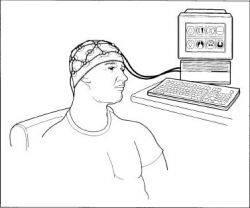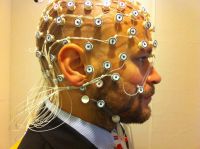Brain-computer interfaces have offered the opportunity for highly disabled patients with motor disabilities to live more normal lives. The recent innovations in thought-controlled wheelchairs using EEG technology will allow patients to not only communicate with their surroundings but to also navigate around them. The development of this technology could potentially make a huge impact on the health care industry and the lives of those confined to the boundary of their own bodies.
Introduction
One of our biggest fears is being trapped in small, enclosed spaces. Now imagine being trapped inside of your own body. Completely conscious, you hear everything that people say around you and you can see perfectly fine. You have completely functional cognitive ability; the only problem is that you cannot move or speak. You strain to lift your legs so that you can find somebody, but they won’t budge. You want to scream for help but your mouth does not open because your facial muscles are impaired. You are a prisoner of your own body and there is no way to communicate with the outside world. Is there a way to escape?
The medical term for being trapped in your own body is Locked-in Syndrome. This is where the patient has full awareness but is not able to communicate or move due to the paralysis of voluntary muscles [1]. This fully paralyzing condition may not be common, but partial paralysis is a very real problem. Today, there are about 6 million Americans that are paralyzed to some extent. To put that into perspective, 1 out of 50 Americans are at least partially paralyzed [2].
Paralysis has many causes. It occurs because of injury to the nervous system. The leading causes of paralysis are stroke (29%), damage to the spinal cord (23%), and multiple sclerosis (17%) [3]. Other causes may be degenerative neurological diseases or brain injury. There is no real cure to patients with major body paralysis.
However, the advancements in neurotechnology in the area of brain-computer interfaces may finally allow patients suffering from some form of paralysis to live more independent lives. The development of this technology may be the light at the end of a long tunnel for those trapped in the prisons of their bodies.
The Brain-Computer Interface
A brain-computer interface (BCI) allows the brain to communicate with an external device. It converts the user’s thoughts into actions executed by a computer (Fig. 1).
The mechanism of the BCI can be broken down into the following steps. First, the user visualizes performing a specific simple task, such as moving their right hand. The brain emits specific signals associated with the intent which in this case involves moving the right hand [4]. This electrical activity is measured in voltage differences using an Electroencephalogram, or EEG technology, and is filtered and amplified [5]. Then, a computer interprets the signal and learns the brain patterns associated with moving the right hand. Lastly, the computer software is programmed to recognize this specific pattern so that a certain action will execute every time the user visualizes moving their right hand.
How EEG Works
EEG technology is a way to measure the brain’s electrical activity. This technology utilizes the placement of multiple electrodes either on the surface of the skull or underneath the skull (Fig. 2).
The locations of the electrodes each have their advantages and disadvantages. The skull is a medium that obstructs and distorts the electrical signals from the brain. Therefore placing electrodes on the skull’s interior, immediately on the exposed surface, is more effective since the signals will be measured directly [5]. This practice is specifically referred to as Electrocorticography (ECoG). The disadvantage to this technique is that the procedure to implant the electrodes onto the patient’s brain is invasive. Any invasive procedure comes with complications. In this case the patient risks scarring brain tissue, which may obstruct the measurement of their electrical activity. This would defeat the whole purpose of placing the electrodes on the surface of their brain. The placement of the electrodes on the patient’s scalp is the preferred method since it is non-invasive. The patient typically wears an electrode embedded cap, which is attached to the head using a conductive gel.
The Thought-Controlled Wheelchair
Thought-controlled wheelchairs are still in the research and development phase. These wheelchairs are a superior alternative to voice-controlled wheelchairs. The advantages of thought-controlled wheelchairs are that they respond to commands much faster and that patients who have lost the ability to speak may utilize them. Users wear an EEG cap, which monitors their brain activity. The brain emits specific signals when users visualize moving their hand in a certain direction. The sensor in the wheelchair receives and converts the signal into a command that will prompt a response from the wheelchair. Users will have to go through training so that the wheelchair device can get accustomed to their habits.
The Brain Science Institute-Toyota Collaboration Center came out with their thought-controlled wheelchair in 2009 (Fig. 3). Their system processes signals from the brain at a reasonably fast rate, every 125 milliseconds [6]. This allows the wheelchair to move continuously without experiencing a delay in the system. The fast processing speed also allows the system to display an analysis of the user’s signals in real time. This neuro-feedback gives the user a basis for improving their operation of the wheelchair [7]. In addition, there is a sensor on the user’s cheek so that the user can puff his cheek when he wants to override the system and stop the wheelchair’s motion. Toyota claims that their thought-controlled wheelchair is 95% accurate [6].
Another thought-controlled wheelchair is also being developed at the Federal Institute of Technology in Switzerland. This wheelchair comes with two webcams that process visual information. The feature that distinguishes this wheelchair from Toyota’s wheelchair is that it uses shared control. Shared control means that the wheelchair takes in commands from the user as well as the webcam software [8]. Essentially, the computer software exists to complement the user’s commands so that the user does not have to continuously control the wheelchair in the same direction. For example, the user will command the wheelchair to move in a certain direction. The software will then take over to evaluate and navigate the surrounding area to avoid obstacles in its path. This technology has an override command in the case that the user wants to approach an object instead of steering clear of it [8]. This wheelchair has yet to be tested on paralyzed patients.
Disadvantages
There are some restraints to BCI technology since it is relatively new and still mostly in the research phase. The biggest limitation is accuracy in reading the signals. There are billions of neurons in the human body that are firing various signals at any given time. Also, it is generally difficult to read electrical signals derived from our brains, since they have a very low voltage. Furthermore, there are a lot of noisy signals generated in our surroundings that have a higher voltage and may interfere with the detection of the precise signals of our brain. Subsequently, precise filtration must be used to isolate the specific brain signal from outside noise and from the other signals produced by the neurons in the body. Another limitation is maintaining mental activity while focusing on a specific action. Concentrating on executing even a simple task may be difficult when distractions come into play. Navigating a wheelchair in an empty test room may be simple, but what about on a crowded street? Unexpected random movement will have to be taken into consideration. These distractions may cause the user’s thoughts to wander and no longer stay focused on the simple mental task controlling the wheelchair’s movements. This may potentially be dangerous, especially in a situation where the user is crossing the street.
The Future of the Thought Controlled Wheelchair
The ongoing development of BCI’s is very exciting especially since they can be used in a diverse range of applications such as the brain-controlled wheelchair. Although the current wheelchair only allows simple movements, engineers hope to increase the number of commands that can be given by the user. The Toyota Collaboration Center is currently developing more efficient dry electrodes, which will increase the accuracy of reading and filtering brain signals [7]. Once this technology is developed, Toyota envisions that commands that are associated with emotion or mental states can be created. The Swiss Federal Institute of Technology is developing an object recognition program that will enable the wheelchair to line up with the edge of tables. This program will ensure the proximity of the chair to the edge and make sure that it does not position itself at a skewed angle to the table [8]. This will allow the user to sit completely perpendicular to the table, identical to those sitting in normal chairs.
Once the thought-controlled wheelchair moves past the R&D phase, it is expected to be useful in the rehabilitation and support of paralyzed individuals. Brain-computer interfaces such as the wheelchair will allow people to interact and communicate more with their surroundings without having to rely entirely on others. It will allow them to make decisions that they had no say in before. This is especially important for those who have completely lost their ability to move or speak. The development of thought-controlled devices will improve the lives of many disabled people who have motor disabilities or paralysis so that they no longer have to feel imprisoned.






